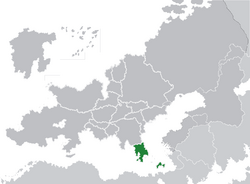Iavonia: Difference between revisions
No edit summary |
No edit summary |
||
| (2 intermediate revisions by the same user not shown) | |||
| Line 75: | Line 75: | ||
|established_event1 = Merchant's Reunification | |established_event1 = Merchant's Reunification | ||
|established_date1 = 21 April 1870 | |established_date1 = 21 April 1870 | ||
|established_event2 = [[ | |established_event2 = [[2024 Iavonian coup d'état]] | ||
|established_date2 = 14 May 2024 | |established_date2 = 14 May 2024 | ||
|established_event3 = | |established_event3 = | ||
| Line 143: | Line 143: | ||
Iavonia is a notable place of philosophical development in Eulabia, with a strong debate tradition and a historically notable role in the spread of scientific and mathematical traditions. Iavonia has historically been separated into smaller kingdoms or city-dependent states, although unification would occur somewhat early into the seventh century BC as a response to incursions from groups in what would later historically be noted as Bolrieg. It would be incorporated into the [[Sabian Empire]] in the second century BC after a series of bloody wars, becoming an integral part of such and continuing for a time the legacy of said empire after its collapse. The Iavonian Orthodox Church played a major role in both of these historical developments, and continues to be a major political and social force into the modern period - with the pre-Republic constitution explicitly acknowledging it as a state religion (while allowing for the right of other religions to be worshipped). Iavonia would be one of the few Kryvian nations to successfully resist [[Isfahan|Isfashani]] conquest, owing to a strong naval presence and issues in transferring supplies across the overstretched Isfashani Empire. | Iavonia is a notable place of philosophical development in Eulabia, with a strong debate tradition and a historically notable role in the spread of scientific and mathematical traditions. Iavonia has historically been separated into smaller kingdoms or city-dependent states, although unification would occur somewhat early into the seventh century BC as a response to incursions from groups in what would later historically be noted as Bolrieg. It would be incorporated into the [[Sabian Empire]] in the second century BC after a series of bloody wars, becoming an integral part of such and continuing for a time the legacy of said empire after its collapse. The Iavonian Orthodox Church played a major role in both of these historical developments, and continues to be a major political and social force into the modern period - with the pre-Republic constitution explicitly acknowledging it as a state religion (while allowing for the right of other religions to be worshipped). Iavonia would be one of the few Kryvian nations to successfully resist [[Isfahan|Isfashani]] conquest, owing to a strong naval presence and issues in transferring supplies across the overstretched Isfashani Empire. | ||
Iavonia would collapse into a series of merchant states following the period of [[Carlo Cavallo]]'s rule over [[Sallia]] and Vitulia, but would reunify as the First Iavonian Republic in 1870. This republic would be replaced by the Kingdom of Iavonia as a result of the monarchy forced upon such during the end of the [[First Great War (Kali Yuga)|First Great War]] by [[Aeyariss]]. This state of affairs would last throughout history until the [[2024 | Iavonia would collapse into a series of merchant states and independent cities following the period of [[Carlo Cavallo]]'s rule over [[Sallia]] and Vitulia, but would reunify as the First Iavonian Republic in 1870. This republic would be replaced by the Kingdom of Iavonia as a result of the monarchy forced upon such during the end of the [[First Great War (Kali Yuga)|First Great War]] by [[Aeyariss]]. This state of affairs would last throughout history until the [[2024 Iavonian coup d'état]], which would establish (or re-establish) the Iavonian Republic. | ||
==Name== | |||
==History== | |||
===Prehistory=== | |||
===Ancient Iavonia=== | |||
===Elinkan Province (???BCE - 4th Century)=== | |||
===Medieval Period (4th - 15th Century)=== | |||
===War of Isfashani Resistance (15th Century - 1814)=== | |||
===Unification of Iavonia (1870)=== | |||
===First Great War=== | |||
===Kingdom of Iavonia=== | |||
===Second Great War=== | |||
===Modern Era=== | |||
====Laziades Coup==== | |||
==Geography== | |||
===Climate=== | |||
===Islands=== | |||
===Biodiversity=== | |||
==Politics== | |||
===Political Parties=== | |||
===Foreign Relations=== | |||
===Military=== | |||
===Legal System=== | |||
==Economy== | |||
===Energy=== | |||
===Tourism=== | |||
===Shipping=== | |||
===Transport=== | |||
==Demographics== | |||
===Religion=== | |||
===Languages=== | |||
===Education=== | |||
===Healthcare=== | |||
==Culture== | |||
===Architecture=== | |||
===Literature=== | |||
===Cuisine=== | |||
{{Sactoverse navbox|state=collapsed}} | {{Sactoverse navbox|state=collapsed}} | ||
Latest revision as of 20:05, 1 July 2024
This article is incomplete because it is pending further input from participants, or it is a work-in-progress by one author. Please comment on this article's talk page to share your input, comments and questions. Note: To contribute to this article, you may need to seek help from the author(s) of this page. |
Iavonian Republic Δημοκρατία της Ιαώνιας | |
|---|---|
|
Flag | |
| Motto: "Ελευθερία ή θάνατος" "Freedom or death" | |
 Location of Iavonia (dark green) in Eulabia (grey) | |
| Capital and largest city | Aulis |
| Official languages | Greek |
| Ethnic groups | Iavonians |
| Religion |
|
| Demonym(s) | Iavonian |
| Government | Transitional government |
• President | Adrian Laziades (interim) |
• Prime Minister | Adrian Laziades |
| Legislature | The Boule |
| Establishment | |
• Merchant's Reunification | 21 April 1870 |
| 14 May 2024 | |
| Area | |
• Total | 525,420 km2 (202,870 sq mi) |
• Water (%) | 1.05% |
| Population | |
• 2022 estimate | 10.432.481 |
• 2019 census | 10.110.078 |
| GDP (PPP) | 2022 estimate |
• Total | $2.972 trillion |
• Per capita | $48,443 |
| GDP (nominal) | 2019 estimate |
• Total | $358 billion |
• Per capita | $34,300 |
| Gini (2019) | 24.0 low |
| HDI (2019) | very high |
| Currency | Iavonian Drachm (£) (IOD) |
| Time zone | UTC +3 (EET) |
| Date format | dd.mm.yyyy (AD) |
| Driving side | right |
| Calling code | +41 |
| ISO 3166 code | IO |
| Internet TLD | .ia |
Iavonia, officially the Iavonian Republic, is a country in Southeast Eulabia. It is situated on the southern tip of the Kryvian subcontinent (although the state has officially declared itself "South Eulabian" in nature). Iavonia shares land borders with Bolrieg to the north, without any other land-based neighbors. The Illian Sea lies to the east of the mainland, the Iavonian Sea to the west, and the Sea of TBD and the Pontus to the south. Iavonia has one of the larger coastlines in Eulabia, with numerous islands being present across the entirety of the coastal boundaries of the state. Its largest city and capital is Atalánte.
Iavonia is a notable place of philosophical development in Eulabia, with a strong debate tradition and a historically notable role in the spread of scientific and mathematical traditions. Iavonia has historically been separated into smaller kingdoms or city-dependent states, although unification would occur somewhat early into the seventh century BC as a response to incursions from groups in what would later historically be noted as Bolrieg. It would be incorporated into the Sabian Empire in the second century BC after a series of bloody wars, becoming an integral part of such and continuing for a time the legacy of said empire after its collapse. The Iavonian Orthodox Church played a major role in both of these historical developments, and continues to be a major political and social force into the modern period - with the pre-Republic constitution explicitly acknowledging it as a state religion (while allowing for the right of other religions to be worshipped). Iavonia would be one of the few Kryvian nations to successfully resist Isfashani conquest, owing to a strong naval presence and issues in transferring supplies across the overstretched Isfashani Empire.
Iavonia would collapse into a series of merchant states and independent cities following the period of Carlo Cavallo's rule over Sallia and Vitulia, but would reunify as the First Iavonian Republic in 1870. This republic would be replaced by the Kingdom of Iavonia as a result of the monarchy forced upon such during the end of the First Great War by Aeyariss. This state of affairs would last throughout history until the 2024 Iavonian coup d'état, which would establish (or re-establish) the Iavonian Republic.

